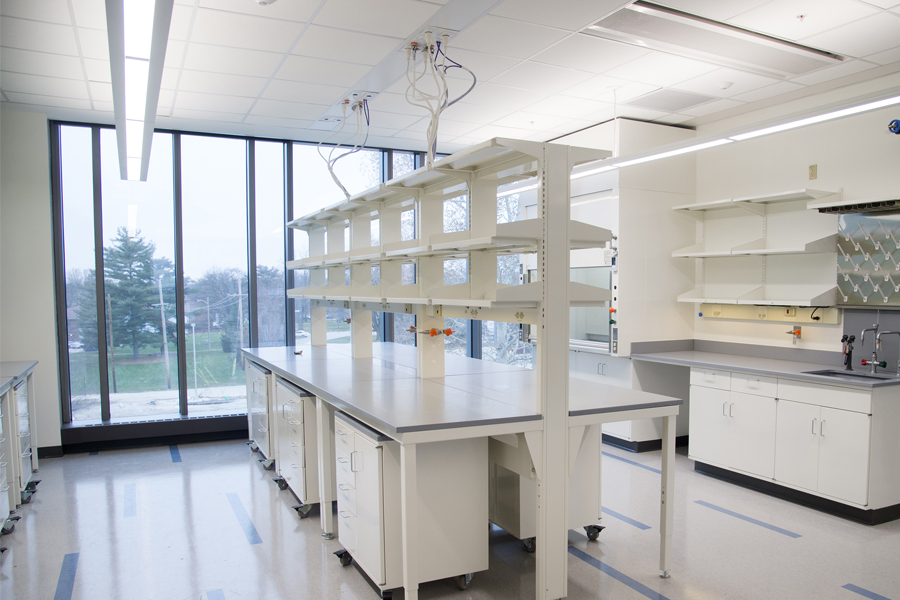Engineering's New FlexLab Building Inspires Cross-Disciplinary Innovation

The FlexLab, which opened in December in Discovery Park, is designed to adapt to the creative and innovative needs of Engineering professors and their students. Its wet-lab, dry-lab and open spaces enable teams to collaborate on interdisciplinary research and discovery that ranges from advanced manufacturing to imaging, and from information technology to medical devices.
Designed by Jacobs/Ennead, the three-story $54 million facility features expanses of glass that allow daylight to brighten work areas and let passersby look in on research. The building includes easily modifiable bench space and labs, open workspace, and work cafes to nurture cross-disciplinary research and fuel the continuing evolution of engineering disciplines. High-bay research space and low-vibration basement labs provide room for specialized optics tables and laser-based machining. The building was supported by a $13.5 million grant from the Lilly Endowment.
“Collaborations never even considered before will become reality as this diverse group of researchers discover common interests and synergistic activities,” says Robert Frosch, senior associate dean of Facilities & Operations for the College of Engineering and professor of Civil Engineering. “The diverse portfolio of research and researchers will create academic collisions that aren’t possible in current facilities. Individuals working in completely different areas of research will interact developing new research opportunities and directions that can’t even be imagined today.”
Engineering researchers applied for space in the building, and more than 95 percent of the approximately 25,100 square feet of laboratory space has already been assigned, according to FlexLab Director David Kish. Among the new occupants is Adrian Buganza Tepole, an assistant professor of mechanical and biomedical engineering who conducts soft matter mechanics in his new lab. In addition to the workspace, the new building allows him to house his research group in one place, as opposed to scattered in different places around campus.
“In the FlexLab, there are multiple mobile workstations that can easily allow for undergraduate and graduate students to work in the same environment as their mentors. The cohesiveness of the group is something that also impacts recruitment of top candidates for graduate school,” Tepole says. “The FlexLab offers a unique setting to do everything I need, from continuing my focus on modeling and numerical methods, to carrying out experiments on my own for characterization of soft matter deformation in applications from skin modeling to hydrogel mechanics.”

Fang Huang, an assistant professor at Purdue’s Weldon School of Biomedical Engineering, is using the facility to focus on developing ultra-high resolution imaging methods and study cell division. The low-vibration specialized optics lab allows his research group to continue pushing the envelope on imaging resolution and depth, and the open space inspires collaborative work on cellular structural and dynamics imaging. Huang will work alongside researchers focused on areas including high-accuracy 3D imaging; energy applications for national defense and security; and the manufacture of particulate products including foods and feed, consumer goods, specialty chemicals, agricultural chemicals, pharmaceuticals, and energetic materials.
“The building features a large number of teaming rooms and focus areas that allow for the spontaneous and energizing formation of collaborative efforts and research discussions,” Huang says. “The facility was designed and constructed with the excitement of research in mind.”
Nate Schultheiss, director of Unconventional Energy in the Davidson School of Chemical Engineering, will use the FlexLab for work on upstream oil and gas research to maximize hydrocarbon recovery from the Illinois Basin and beyond. The group is focused on chemical enhanced oil recovery, with experience in reservoir characterization, drilling, stimulation/hydraulic fracturing and production chemicals.
“Research in oil and gas is multidisciplinary, and the FlexLab provides the perfect setting to view, and potentially involve, areas of innovation which would not have been known about if siloed in a particular department or building,” Schultheiss says. “The FlexLab will provide a laboratory environment with like-minded scientists conducting research in areas of both upstream and downstream. Having a centralized effort in petroleum research in one building is very exciting.”
If the reactions of Schultheiss, Tepole and Huang are any indication, the FlexLab has already exceeded expectation. “It will certainly improve my research group productivity by enabling more group work, help me recruit top candidates, enhance my collaborations, and allow me to broaden the focus of my group. It is simply an amazing opportunity,” Tepole says.

